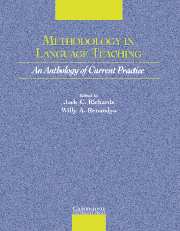Book contents
- Frontmatter
- Contents
- Acknowledgments
- Introduction
- Section I Approaches to Teaching
- Section 2 Lesson Planning and Classroom Management
- Section 3 Classroom Dynamics
- Section 4 Syllabus Design and Instructional Materials
- Section 5 Task and Project Work
- Section 6 Learning Strategies
- Chapter 11 Language Learning Strategies in a Nutshell: Update and ESL Suggestions
- Chapter 12 Learner Strategy Training in the Classroom: An Action Research Study
- Section 7 Teaching Grammar
- Section 8 Teaching Pronunciation
- Section 9 Teaching Speaking
- Section 10 Teaching Listening
- Section 11 Teaching Vocabulary
- Section 12 Teaching Reading
- Section 13 Teaching Writing
- Section 14 Assessment
- Section 15 Technologies in the Classroom
- Section 16 Professional Development
- Credits
- Author Index
- Subject Index
- References
Chapter 12 - Learner Strategy Training in the Classroom: An Action Research Study
Published online by Cambridge University Press: 10 November 2010
- Frontmatter
- Contents
- Acknowledgments
- Introduction
- Section I Approaches to Teaching
- Section 2 Lesson Planning and Classroom Management
- Section 3 Classroom Dynamics
- Section 4 Syllabus Design and Instructional Materials
- Section 5 Task and Project Work
- Section 6 Learning Strategies
- Chapter 11 Language Learning Strategies in a Nutshell: Update and ESL Suggestions
- Chapter 12 Learner Strategy Training in the Classroom: An Action Research Study
- Section 7 Teaching Grammar
- Section 8 Teaching Pronunciation
- Section 9 Teaching Speaking
- Section 10 Teaching Listening
- Section 11 Teaching Vocabulary
- Section 12 Teaching Reading
- Section 13 Teaching Writing
- Section 14 Assessment
- Section 15 Technologies in the Classroom
- Section 16 Professional Development
- Credits
- Author Index
- Subject Index
- References
Summary
When I was in secondary school, I seldom asked questions. The reason was that the teacher always tried to explain the stuffs as detailed as possible, leaving no queries among students. Only the most curious student will ask questions. This method is well-known as the spoon-feeding education system in which we are fed with piles of notes and text books. On the other hand, students … only care about getting results good enough to enter a university. Students gradually become examination oriented. Eventually less and less students care about acquiring knowledge, which should be the aim of education. But in universities, things are totally different. Lecturers only give a brief talk on the topics, leave a hugh area for students to explore by themselves. This means that spoon-feed system no longer exists. Students cannot rely on the knowledge acquired in lectures.
Sandy [pseudonym], a first-year student at the University of Hong Kong)INTRODUCTION
It was students such as Sandy who prompted me to carry out an action research study at the University of Hong Kong. Because of my students' prior schooling experience, they expect the teacher to structure the learning situation for them, telling them what to learn and how to learn, as their high school teachers have done. Many of them have difficulty coming to terms with the very different learning environment that they encounter once they enter college.
Information
- Type
- Chapter
- Information
- Methodology in Language TeachingAn Anthology of Current Practice, pp. 133 - 144Publisher: Cambridge University PressPrint publication year: 2002
References
Accessibility standard: Unknown
Why this information is here
This section outlines the accessibility features of this content - including support for screen readers, full keyboard navigation and high-contrast display options. This may not be relevant for you.Accessibility Information
- 8
- Cited by
